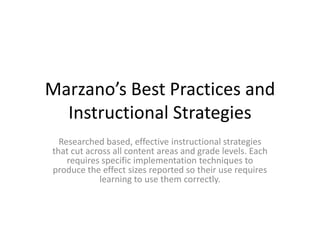
Marzano’S Best Practices And Instructional Strategies
- 1. Marzano’s Best Practices and Instructional Strategies Researched based, effective instructional strategies that cut across all content areas and grade levels. Each requires specific implementation techniques to produce the effect sizes reported so their use requires learning to use them correctly.
- 2. Identifying Similarities and Differences Learning to classify and discern differences and similarities prepares students for employing metaphor, analogy, and high-order thinking skills. These processes are connected as each requires students to analyze two or more elements in terms of their similarities and differences in one or more characteristics. This strategy has the greatest effect size on student learning. Techniques vary by age level.
- 3. Summarizing and Note Taking To summarize is to fill in missing information and translate information into a synthesized, brief form. Effective summarization requires analysis that leads to deeper understanding. Note taking is the process of students’ using notes as a work in progress and/or teachers’ preparing notes to guide instruction. Students benefit from taking notes in both linguistic and visual forms.
- 4. Reinforcing Effort and Providing Recognition Students attitudes and beliefs have a significant effect on success in school. Achievement can increase when teachers show the connection between effort and success. Simply teaching many students that added effort will pay off in terms of achievement actually increases student achievement more than techniques for time management and comprehension of new material. Praise, when recognizing students for legitimate achievements, is also effective.
- 5. Homework and Practice These provide students with opportunities to deepen their understanding and skills relative to presented content. Effectiveness depends on quality and frequency of teacher feedback, among other factors.
- 6. Nonlinguistic Representation Knowledge is generally stored in two forms – linguistic form and imagery. Simple yet powerful non-linguistic instructional techniques such as graphic organizers, pictures, and pictographs, concrete representations, and creating mental imaged improve learning. The more students use both systems, the better they are able to think about and recall information.
- 7. Cooperative Learning Effective when use right, ineffective when overused. Students still need time to practice skills and processes independently. Can promote student learning and build interpersonal skills when done wisely and support structures are in place.
- 8. Setting Objectives and Providing Feedback Goal setting is the process of establishing direction and purpose. Teachers communicate learning goals to students every day. Focus students on meeting those goals and greatly improve their chances of success. Providing frequent and specific feedback related to learning objectives is one of the most effective strategies to increase student achievement. Criteria for success and specific, timely feedback can help increase students understanding and improve learning.
- 9. Generating and Testing Hypothesis Involves students directly in applying knowledge to a specific situation. Deductive thinking (making a prediction about a future action or event) is more effective than inductive thinking (drawing conclusions based on information known or presented). Requires careful orchestration of experience. Technology tools can add authenticity to the learning experience.
- 10. Cues, Questions, and Advance Organizers These strategies help students retrieve what they already know on a topic. Cues are straight-forward ways of activating prior knowledge Questions help students to identify missing information Advanced organizers are organizational frameworks presented in advance of learning. Increases students readiness for learning and connect new ideas to existing knowledge.
- 11. Vocabulary Research indicates that student achievement will increase by 12 percentile points when students are taught 10-12 words per week. Student achievement will increase by 33 percentile points when vocabulary is focused on specific words important to what students are learning. Requires specific approaches.
- 12. Simulation and Games Simulation offers unique opportunities to enhance learning and allow students to test knowledge, gain experience and practice skills. Usually part of Building Academic Vocabulary.
- 13. Thematic Instruction Thematic Instruction is not one of Marzano’s Strategies or Best Practices. However, when used with upper elementary, students can learn better from thematic, interdisciplinary instruction. Themes are a way of understanding new concepts and provide mental organizing schemes. Provided they are taught using Marzano’s Strategies or Best Practices.
- 14. Disclaimer These do not work all the time. They may decrease learning if not used correctly and with the right content. Some teachers have their own strategies that are effective but have never been researched. Research points in favor of these strategies.
- 16. Other Reading Art and Science of Teaching Dimensions of Learning